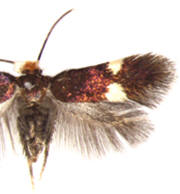|
A Key to the superfamilies of the Lepidoptera
with special reference to North and South Dakota
9 (8).
Maxillary palpus folded at rest, with four or five segments, when extended,
more than ½
as long as labial palpi. Superfamily
Nepticuloidea. |
Folded maxillary palpi.
Examples pictured are tineids rather than nepticuloids.
The
Nepticuloidea can be recognized by their lack of a hindwing discal cell, folded
maxillary palpi and enlarged scape of the antenna forming an eyecap.
Nepticuloidea are divided into two families as follows:
|
Nepticulidae are minute dark colored,
often metallic moths with at least one stalked vein on fw. About 800
species are known worldwide, 98 species in 5 genera of which occur in North America.
The smallest known moths are members of this family. |
 |
|
Opostegidae are usually white moths with all fw
veins separate. Worldwide, 102 species are known, seven of which occur in
North America. |
|
9.' Maxillary
palpus of three or fewer segments, if four or five segmented then maxillary palpus
minute, not folded and less than length of 2nd segment of labial palpus.
Labial palpus
upturned or drooping
Go to 9a. |
A copromorphid
(left) and gracillariid (right) illustrating short maxillary palpi and longer,
upturned labial palpi.
Return to beginning of
Key
Return to Key introduction
|
